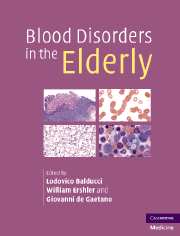Book contents
- Frontmatter
- Contents
- List of contributors
- Preface
- Part I Epidemiology
- Part II Hematopoiesis
- 5 Stem cell exhaustion and aging
- 6 Hematopoietic microenvironment and age
- 7 Replicative senescence, aging, and cancer
- 8 Qualitative changes of hematopoiesis
- 9 Aging and hematopoietic stress
- 10 Immunoglobulin response and aging
- 11 Biological and clinical significance of monoclonal gammopathy
- Part III Anemia of aging
- Part IV Hematologic malignancies and aging
- Part V Disorders of hemostasis in the elderly
- Index
6 - Hematopoietic microenvironment and age
from Part II - Hematopoiesis
Published online by Cambridge University Press: 21 October 2009
- Frontmatter
- Contents
- List of contributors
- Preface
- Part I Epidemiology
- Part II Hematopoiesis
- 5 Stem cell exhaustion and aging
- 6 Hematopoietic microenvironment and age
- 7 Replicative senescence, aging, and cancer
- 8 Qualitative changes of hematopoiesis
- 9 Aging and hematopoietic stress
- 10 Immunoglobulin response and aging
- 11 Biological and clinical significance of monoclonal gammopathy
- Part III Anemia of aging
- Part IV Hematologic malignancies and aging
- Part V Disorders of hemostasis in the elderly
- Index
Summary
Introduction
Considerable evidence supports the concept that the localization of hematopoiesis to the bone marrow (BM) in adult mammals involves developmentally regulated interactions between primitive hematopoietic stem cells (HSCs) and the stromal cell-mediated hematopoietic microenvironment (HM) of the marrow. Moreover, it is well accepted that stromal cells and their extracellular biosynthetic products play a critical role in many aspects of hematopoiesis including the regulation, recruitment, and retention of hematopoietic stem and progenitor cells within preferred sites of the BM. Therefore, conceptually at least, there are two key cellular components for consideration when discussing the effects of aging on hematopoiesis: first the hematopoietic stem and progenitor cells themselves, and second those cells that comprise the hematopoietic microenvironment. In this chapter we review the current understanding of what constitutes the HM and how its components and functions change during aging and thereby impact specifically on primitive hematopoietic progenitor cells and hematopoiesis. In the final section, we highlight the unresolved questions concerning the effect of age on the HM and suggest a series of studies to further our understanding of this biology. Finally, we acknowledge the publications and contributions made by many investigators over the last four decades or more, and apologize to those whose work we may have inadvertently not referenced in this review.
- Type
- Chapter
- Information
- Blood Disorders in the Elderly , pp. 71 - 83Publisher: Cambridge University PressPrint publication year: 2007

